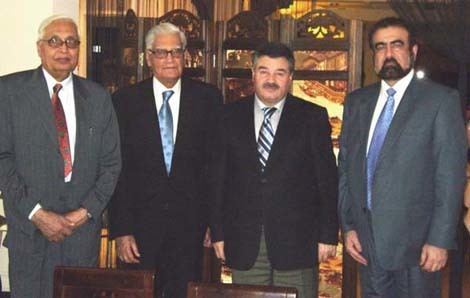Citizenship Pakistan Residence Islamabad, Pakistan Name Ahsan Mubarak | Nationality Pakistani Fields Geophysics | |
 | ||
Institutions Pakistan Atomic Energy Commission
Quaid-e-Azam University
National Centre for Physics
Center for Earthquake Studies (CES) Known for Nuclear deterrence program
Research work on Gravity anomaly, vertical deflection, seismic differential waves, and the Seismic inversion Alma mater University of London, University of Karachi | ||
Notable awards Sitara-e-Imtiaz (1999) | ||
Ahsan Mubarak (Urdu: احسن مبارک; ), is a Pakistani geophysicist and nuclear seismologist who is renowned for his pioneering research on earthquake sciences, and seismic activities in Pakistan. He is the current director of the Center for Earthquake Studies (CES), senior scientist at the Global Network for the Forecasting of Earthquakes (GNFE) and a visiting professor of geophysics at the Quaid-e-Azam University.

Biography
Ahsan attended and graduated from the Karachi University, where he gained BSc in Physics and BA in Mathematics, followed by double MSc in Mathematics and Geology. After his master's degree, Ahsan served as lecturer in geology and taught undergraduate courses on Mathematics before joining the Pakistan Atomic Energy Commission (PAEC) in 1960s. In 1961, Ahsan joined the PAEC and earned a scholarship for his doctoral studies. In 1962, Ahsan joined the doctoral programme of the London University, and began doctoral research on geophysics. In 1966, Ahsan was awarded Doctor of Science in Geophysics after writing a brief thesis on Radiometric dating and its relative expansion on the Geochronology. In 1967, Mubarak return to his country and joined the senior staff of the PAEC where he engage research on Seismic waves and the Exploration geophysics. In 1969, he was among the five top senior scientists who were selected by the PAEC to receive technical training at the plutonium production facility in Windscale, United Kingdom. Upon return, Ahsan advised the government to acquire the key components, materials and facilitated drafts instead of purchasing the entire site which PAEC can built ingeniously.
Dr. Ahsan Mubarak was recruited by fellow scientist and nuclear physicist dr. Ishfaq Ahmad to join the country's clandestine, large-scale atomic bomb project in 1976. He was a part of PAEC team led by Ishfaq Ahmad which commenced a three-dimensional space survey to find a suitable location for an underground nuclear test, preferably a mountain. The over span of three days and had made several reconnaissance tours of the areas of Balochistan Province. He helped to develop a wide range three-dimensional sites to conduct the nuclear tests, and was set as team leader of a study group to study the effects of blast waves, shock waves and seismic waves generated by the weapon to effect the shape of the site and effects on earth. Ahsan was among the few scientists who were actually inivited to eye-witness the first nuclear tests conducted in 1998, see codenames Chagai-I and Chagai-II. While at the detonation process, Mubarak helped the Mathematical Physics Group (MPG) to calculate and approximate the exact yield generated by the devices. For this, he was honoured by the government and is a recipient of Sitara-e-Imtiaz which was honoured to him in 1999.
In 2005, he became founding director of the Center for Earthquake Studies (CES) after experiencing the disastrous 2005 Pakistan earthquake. Since 2005, he has been a public figure educating the country on seismic activities and earthquake sciences. In 2008, Mubarak became senior scientist at the Global Network for the Forecasting of Earthquakes and currently serving as the chief scientist representing Pakistan. In 2010, Mubarak became visiting professor of Geophysics at the Department of Earth Sciences of the Quaid-i-Azam University.
